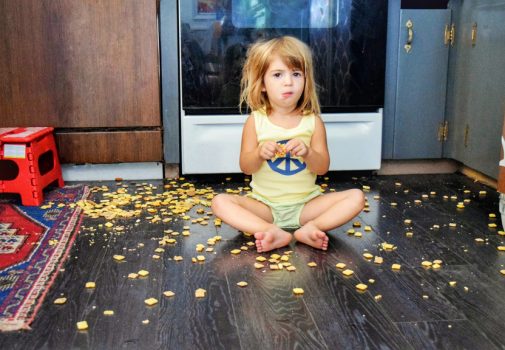Is the five-second rule for food a myth?

We’ve all heard of the five-second rule: if your food doesn’t touch the floor for more than a few seconds, you’re good to pick it up and eat it. But does science support this so-called rule, or is it just a myth? An article from a professor of food science may make you change your habits.
The Clemson University professor looked at a breadth of past research on the topic. One particularly interesting study out of his lab examined how much bacteria is transferred from the time food falls on the floor to when it is picked up. The research team swabbed squares of tile, carpet and wood with Salmonella, a bacteria which can cause diarrhea and fever, and then placed bologna and bread on the floor for five, 30 or 60 seconds before measuring the amount of bacteria that transferred to the food.
They discovered that when food was picked up from tile or wood floors, 48-70 percent of the bacteria was transferred. Interestingly, the length of time the food spent on the floor didn’t matter. Instead, it was the amount of bacteria on the floor that impacted the likelihood and percentage of bacteria that was transferred.
Even smaller foods like cookies and gummy bears had bacteria transferred onto them when they were only on the floor for less than five seconds. The researchers also noted that the type of surface made a difference in terms of bacteria transfer; carpets performed better than wood or tile.
A comparable study was performed in the UK with similar parameters, and the results were the same. Researchers found it didn’t matter if the food was on the floor for three seconds or 30 seconds, but it was the amount of bacteria on the floor that really made a difference. Surprisingly, the study also surveyed participants and found that a shocking 87 percent said they had eaten or would eat food dropped on the floor.
“In order to avoid the spread of bacteria, especially when it comes to eating food off the floor, simply throw it away to avoid the risk,” says Dr. Adam Treitman, an infectious disease doctor at Advocate Christ Medical Center in Oak Lawn, Ill.
Dr. Treitman recommends these tips to avoid food contamination:
- Wash hands before eating and before, during and after food preparation
- Keep countertops clean, preferably with a bleach solution
- Replace hand towels and sponges regularly
- Sanitize your kitchen sink and drain disposal
- Wipe eating areas before and after meals
Related Posts
Comments
4 Comments
About the Author
health enews staff is a group of experienced writers from our Advocate Health Care and Aurora Health Care sites, which also includes freelance or intern writers.


















I understand that the five-second rule has been debunked, but has anyone ever studied the likelihood of Salmonella bacteria being on any given floor? Does the bacteria breed from nothing, or does it have to be transferred or transmitted from somewhere?
It seems to me that this “myth” is promoted by practical application. How many of us have dropped something on the floor, promptly picked it up, and ate it AND THEN came down with anykind of disease? I suggest that not many of us have ever come down with anything that could be related to the floor. A reasonably clean floor is the key to the five second rule.
Tom Sommer, I would definitely agree. David Latz, very excellent question.
Growing up it was five second rule and then you kissed it up to God.